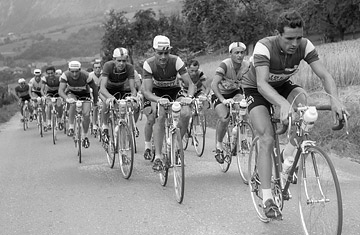
Tour de France, 1960
The Tour de France, which kicks off July 5, is a grueling test of human endurance, a three-week 2,175mile (3,500 km) race stretched over 21 stages, nine of them in the mountains. But in some ways the modern Tour is easier than races past. In the early 20th century, competitors pedaled the dirt roads of France through the night on fixed-gear bikes, evading human blockades, route-jamming cars and nails placed on the road by fans of other riders. Between stages, teams feasted on banquets and champagne; before climbs, they fortified with cigarettes.
The race was the brainchild of Henri Desgrange, a Parisian magazine editor who launched it in 1903 with 60 riders in a bid to boost circulation. It worked: Tour coverage helped Desgrange's magazine boom, and the race soon became more popular than he could have dreamed. With fans lining the roads to see riders up close, by the 1920s the Tour included more than 100 cyclists from throughout Europe. But as the competition grew fiercer and the race more commercialized, champagne and nicotine gave way to more effective--and insidious--performance boosters. In 1967, British rider Tom Simpson died midrace after taking amphetamines, prompting the event to adopt drug-testing. In 1998 authorities disqualified the Festina team after finding the red blood cell--boosting drug EPO in their car. The winner of the 1996 race, Bjarne Riis, admitted in 2007 that he had used EPO, just months before Floyd Landis became the first Tour winner stripped of his title on charges of using synthetic testosterone in 2006. The Tour now tests athletes rigorously--stage winners are screened daily--although the victor in this year's race will still be allowed a sip of champagne.
